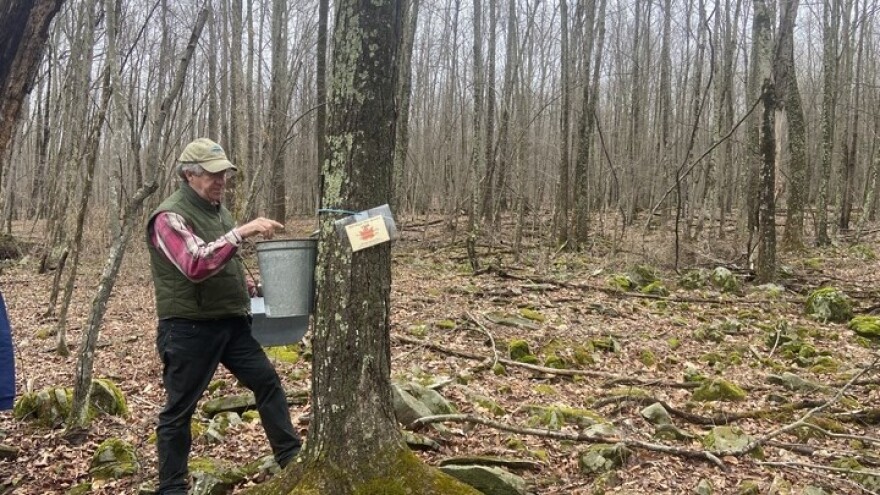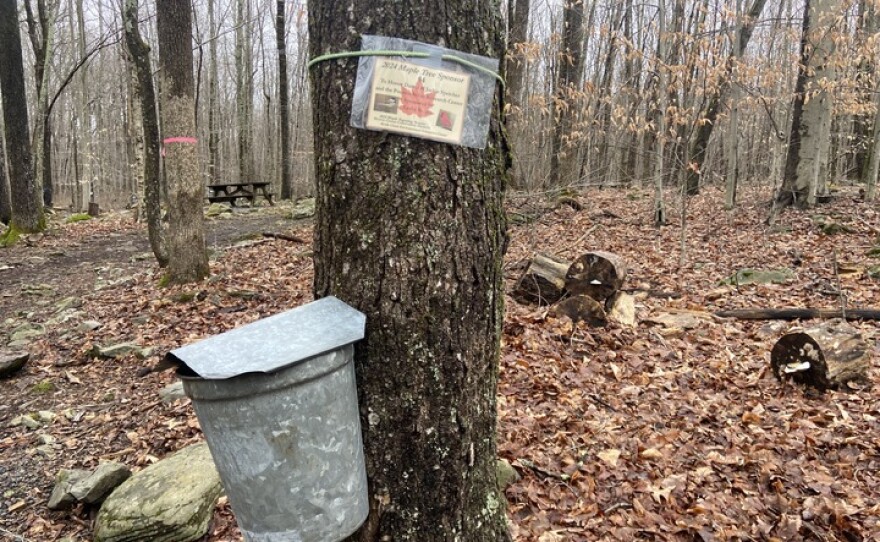MIDDLE SMITHFIELD TWP., Pa. — Over the years, the tools used to extract sap from maple trees have changed, Roger Spotts says.
However, the process of making maple syrup has largely stayed the same.
“We've gone from wooden tools, wooden spiles [a small spigot] to metal spiles, metal tools, and now most of it is done with plastic,” said Spotts, an environmental education coordinator with the Monroe County Conservation District. “But no matter how it's done, it's all the same — you're still taking the sap out of the tree and cooking it until you have syrup.”
Pennsylvania’s maple sugaring season is well underway, an annual end-of-winter tradition for farmers, conservationists and residents across the commonwealth.
At the conservation district’s Meesing Outdoor Site’s Singing Hemlock Sugar Shack, educators Thursday guided visitors through the history of maple syrup production, how maple sap is collected and processed today, as well as the differences between pure maple syrup and the manufactured syrups widely available on grocery store shelves.
Pennsylvania is the nation's fifth-largest producer of pure maple syrup, according to the state Department of Conservation and Natural Resources. Nearly 200,000 gallons are produced per year, worth about $5.4 million.
“Some of these trees have been tapped for almost 50 years; every year they get tapped. So we have to take care of the trees.”Roger Spotts, environmental education coordinator with the Monroe County Conservation District
“We need to find a maple tree at least 8 inches around,” Spotts said as he led a group into the sugarbush, or the forest of maple trees where sap is harvested, around the shack. “Some of these trees have been tapped for almost 50 years; every year they get tapped. So we have to take care of the trees.
“When the season is over, we go to all these trees and we pull the spiles out and then the tree very slowly closes the hole — like a cut on your finger when it heals.”
Indigenous, colonial maple-tapping
The Lenape, an indigenous group to northeastern Pennsylvania and beyond before European colonialism, collected sap from maple trees, said Derek Lederer, an environmental educator with the conservation district. Sap was poured into a trough carved from wood before hot stones were added, boiling off the water to leave the sugar behind. It could take days.
“It’s 98% water and 2% sugar,” Lederer said. “And it takes 40 to 50 gallons of sap to get one gallon of maple syrup.”
When Europeans overtook the landscape, maple tapping continued, but the process changed with metal tools and pots.
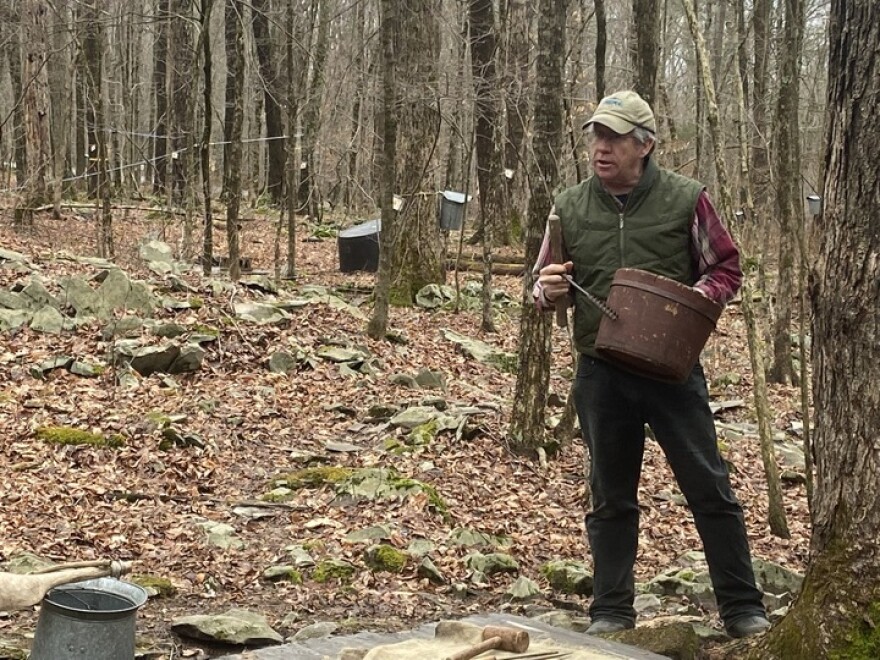
“They cooked it down until it made sugar, just like the Native Americans, but eventually, as more people came in the area, they started to get more tools and be more efficient,” Spotts said. “And then they even had containers they could put liquid syrup in.”
While sap is collected in the winter, it’s created in the summer.
Through photosynthesis, the process plants use involving sunlight to convert carbon dioxide and water into food, sap is created in a maple tree’s leaves. While the sap flows around the entire tree to nourish it, when the weather turns colder and leaves die and drop off, the sap retreats into the tree’s roots.
“At the end of winter, it starts to get warmer. The tree needs that sap to make the new leaves grow,” Spotts said. “So, on warmer days, it actually sucks the sap out of the roots and it goes up the trunk of the tree, on the inside, and goes toward the top of the tree.
“That is the time, if we drill a hole in the tree, some of that sap will run out and into our bucket.”
Cold nights and warm days are best for maple tapping, he added. The ideal is an overnight temperature of 25 degrees, followed by a day with highs around 45 degrees with sunny skies.
But, even under perfect conditions, the collection process is slow.
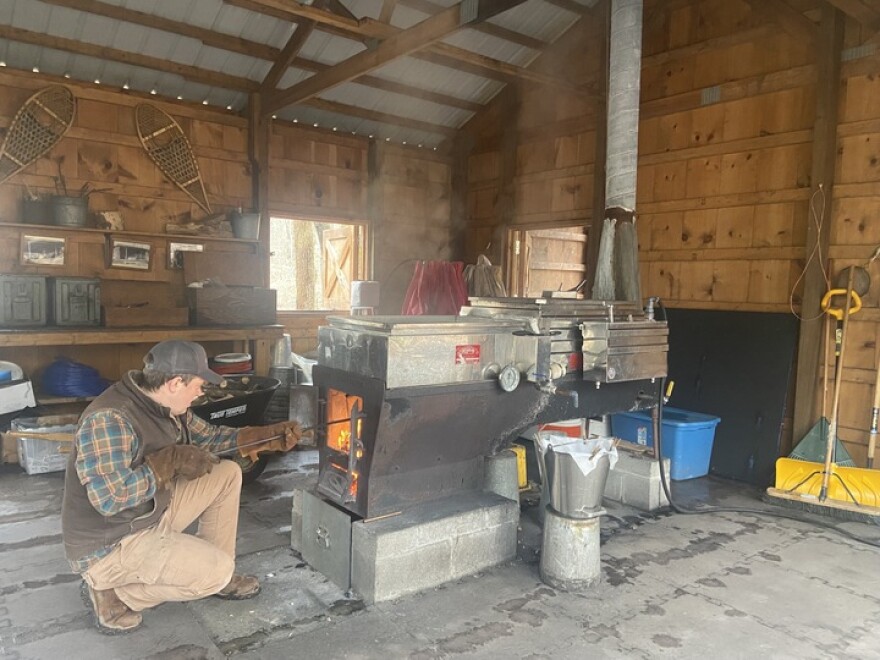
“On a good day, it will be dropping out one drop at a time. they come out, drop, drop, drop, drop,” Spotts said. “Every tree is a little different. Some trees will give more than others. The size helps, but also some trees just produce more sap or you hit a good spot.”
Inside the sugar shack
After the sap is collected, it’s taken to the sugar shack, where it’s poured through a screen to filter any debris or insects and into a 300-gallon steel tank.
“We collected 250 gallons of sap in one day last week,” Spotts said. “Yesterday, we got about 40 gallons of sap. Today, we're not even going to collect; there's not enough. We're running out of sap because it's getting too warm.”
A hose from the tank feeds the shack’s evaporator, the machine that processes the liquid into syrup. When the evaporator hit between 213 and 214 degrees, Barrett Donna, an environmental educator with the conservation district, completed a drip test, using a spoon to check the density of the boiling liquid to make sure it’s just right.
Then, the syrup is filtered one more time before it’s cooled and bottled.
The smell of this sugar shack is amazing!! pic.twitter.com/yQJeD3nSIh
— Molly Bilinski, artisanal sentence crafter (@MollyBilinski) March 7, 2024
“It's pretty hard work — all that hard work pays off,” Donna said, holding up a gallon jug. “One gallon bottle of maple syrup is really expensive. If you bought this at a store, it’s going to be like $50 or $60.”
When tapping maple trees, it’s common to get different flavors of syrup over the course of the season, Donna said. The first is almost clear and very sugary, while those proceeding get darker and more flavorful.
“The flavor intensity goes up the darker it gets,” he said, adding that syrup is graded by flavor and color.
It’s pretty easy to tell if maple syrup on grocery store shelves is pure or not, he said.
“There won't be an ingredients list because nothing gets added. It's just the maple sap that came out of the tree and we evaporated a lot of that water out,” he said, replacing the jug on the table and exchanging it for a store-brand syrup. “You might casually call this maple syrup, but this doesn't have the word maple on it anywhere. It's not called maple syrup. There's no maple in the ingredients list.”
Sometimes called table or flavored syrup, it often has corn syrup, high fructose corn syrup, cellulose gum to make it “thick and gloopy” and sodium hexametaphosphate, a preservative.
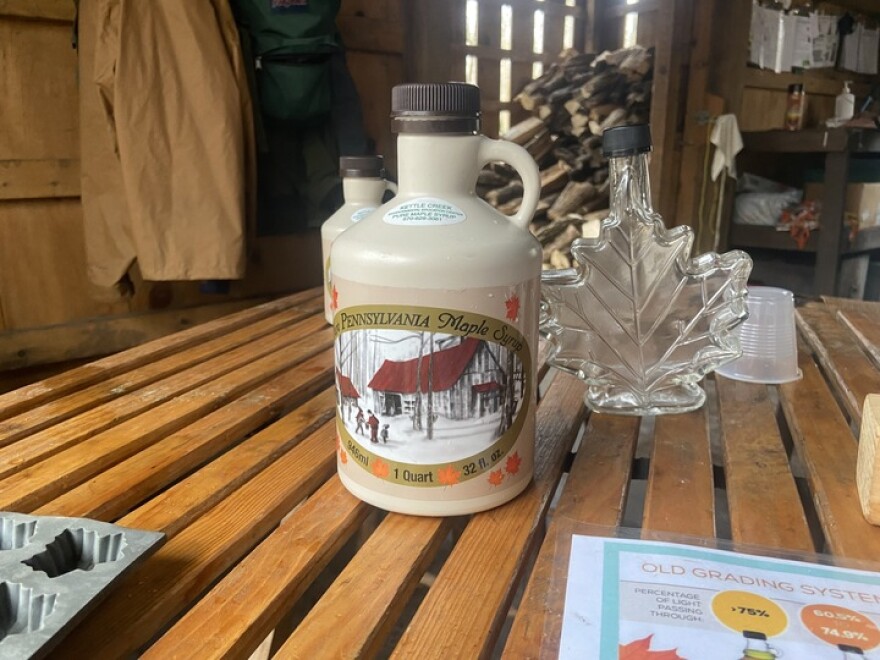
Donna offered visitors to blind taste-test a store-brand syrup alongside a syrup processed at the shack.
Asked to identify which was which, the majority of the group correctly identified the pure maple syrup.
“Tomorrow might be the last day we can cook syrup,” Spotts said. “But I looked at the weather, and the weather said next week it's gonna get a little cold again, so we'll hopefully get some more sap next week.
“Because if it gets warm and stays warm, we're done until next February when we make it again.”

